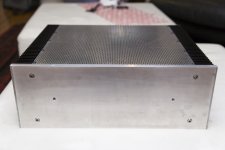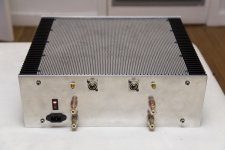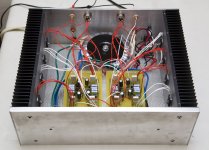Luck
Whenever I have a fault on a board, I try to choose a methodical system to track it down. No matter what method I employ, I always end up finding the faulted part in the last sweep of the board.
Tonight, I thought I'd try something different. Resist my usual instinct and "do the opposite". Sure enough, the faulted part was in the last set to be checked (I checked them all).
The lesson: "While human error sucks, you can't beat fate."
I don't have time to try the board tonight, though I'm as confident as one can be, without testing, that I fixed the fault.
Tomorrow brings testing and biasing, and hopefully listening though both channels.
Whenever I have a fault on a board, I try to choose a methodical system to track it down. No matter what method I employ, I always end up finding the faulted part in the last sweep of the board.
Tonight, I thought I'd try something different. Resist my usual instinct and "do the opposite". Sure enough, the faulted part was in the last set to be checked (I checked them all).
The lesson: "While human error sucks, you can't beat fate."
I don't have time to try the board tonight, though I'm as confident as one can be, without testing, that I fixed the fault.
Tomorrow brings testing and biasing, and hopefully listening though both channels.
Whenever I have a fault on a board, I try to choose a methodical system to track it down. No matter what method I employ, I always end up finding the faulted part in the last sweep of the board.
Well of course it is. Why would you keep sweeping the board after you found it? 😉 😀
More Progress - she's biased!
I sweep the whole board, you never know, there may be more than one issue. The rule stands even sweeping the whole board!
On to better news. I had a moment this morning, and biased the amp. It biases easily, all channels. It's rock stable at thermal equilibrium. I don't have a moment to play music, that comes tonight.
Well of course it is. Why would you keep sweeping the board after you found it? 😉 😀
I sweep the whole board, you never know, there may be more than one issue. The rule stands even sweeping the whole board!
On to better news. I had a moment this morning, and biased the amp. It biases easily, all channels. It's rock stable at thermal equilibrium. I don't have a moment to play music, that comes tonight.
This is why it is a good idea to bring up the AC mains voltage slowly while watching the current draw in one or more ways... also this is a good example where fuses can save one a lot of time and money. I'd rather blow a whole lot of fuses, even fuses that are rated too low for early testing protection over expensive devices...
I do not like to keep fuses in rail lines once the amp is stable, but that's me. I live dangerously. 😀
_-_-bear
I do not like to keep fuses in rail lines once the amp is stable, but that's me. I live dangerously. 😀
_-_-bear
I have started up my development stereo Power Amp a few times on it's F1A fuse.
Still intact.
But I tested via a light bulb at every stage of construction.
Still intact.
But I tested via a light bulb at every stage of construction.
This is why it is a good idea to bring up the AC mains voltage slowly while watching the current draw in one or more ways... also this is a good example where fuses can save one a lot of time and money. I'd rather blow a whole lot of fuses, even fuses that are rated too low for early testing protection over expensive devices...
I do not like to keep fuses in rail lines once the amp is stable, but that's me. I live dangerously. 😀
_-_-bear
Would the fuses have blown in this case with a variac, but not on full power? My fuse didn't blow.
Anyway, I took a moment out of the day and try some music. Both channels are awesome! Very fast and crisp highs, full clean lows.
I'm going to spend some real time with the amp tonight and get some pictures up.
Depends on what you used for rail fuses, and the nature of the fault.
For example if the fault caused a very high frequency oscillation, you would not see that fault show up (proably) until the rail voltages started to get up and then the death would likely be fast and final if it was of high enough amplitude... that's what a scope is for... although one does not always catch such things.
Otoh, your fault obviously caused excess current to be drawn in some component, so the question is how much current was too much... and how was that caused.
Some faults can not be caught before they occur, some can. The idea is that if you know the maxium normal draw of the amp as a whole via the AC mains, you can monitor that. If you know the maximum draw (the normal quiescent current) of a rail, you can monitor that as you turn the AC mains and so the PS up in voltage... if it starts to go high with rather not a lot of AC mains then you know you have a fault. This way you catch a problem before it can cause an early death of a component.
This is not 100% foolproof, but it does work in >90% of the cases, maybe more like 98+% of the cases...
_-_-bear
For example if the fault caused a very high frequency oscillation, you would not see that fault show up (proably) until the rail voltages started to get up and then the death would likely be fast and final if it was of high enough amplitude... that's what a scope is for... although one does not always catch such things.
Otoh, your fault obviously caused excess current to be drawn in some component, so the question is how much current was too much... and how was that caused.
Some faults can not be caught before they occur, some can. The idea is that if you know the maxium normal draw of the amp as a whole via the AC mains, you can monitor that. If you know the maximum draw (the normal quiescent current) of a rail, you can monitor that as you turn the AC mains and so the PS up in voltage... if it starts to go high with rather not a lot of AC mains then you know you have a fault. This way you catch a problem before it can cause an early death of a component.
This is not 100% foolproof, but it does work in >90% of the cases, maybe more like 98+% of the cases...
_-_-bear
Pictures and more to do...
Here are a few pictures of the Cascoded Balanced F5.
I'm very happy with the how the project came out. I still have a lot to do. This case was intended for a very different amp, and has been pressed into service to test the Cascoded XF5. It is in no way the amp's final home - I have eight large heat sinks that are waiting for these PCBs.
Most of the "To Dos" are cosmetic. The only issue is a faint 60Hz hum (I can hear it if I put my ear to the speaker). I suspect I need the rotate the toroid to the front of the case and put the PCBs at the back (nearer to the inputs/outputs).
The sound is superb - the best I've ever had. As this thread states, I'm trying for the ultimate F5, my next iteration is the Standard Cascoded F5. The PCBs are built and work. I have a case, I need to buy a new toroid and I'll be off to the A/B listening tests.
I'll post more pictures as I swap my NTCs, add feet, rotate the toroid, route wiring to be neater. I hope to have the Standard Cascoded in a test case in about 10 days.
Finally, I cannot thank NP enough. He's a true gentleman and an extremely good teacher.
Here are a few pictures of the Cascoded Balanced F5.
I'm very happy with the how the project came out. I still have a lot to do. This case was intended for a very different amp, and has been pressed into service to test the Cascoded XF5. It is in no way the amp's final home - I have eight large heat sinks that are waiting for these PCBs.
Most of the "To Dos" are cosmetic. The only issue is a faint 60Hz hum (I can hear it if I put my ear to the speaker). I suspect I need the rotate the toroid to the front of the case and put the PCBs at the back (nearer to the inputs/outputs).
The sound is superb - the best I've ever had. As this thread states, I'm trying for the ultimate F5, my next iteration is the Standard Cascoded F5. The PCBs are built and work. I have a case, I need to buy a new toroid and I'll be off to the A/B listening tests.
I'll post more pictures as I swap my NTCs, add feet, rotate the toroid, route wiring to be neater. I hope to have the Standard Cascoded in a test case in about 10 days.
Finally, I cannot thank NP enough. He's a true gentleman and an extremely good teacher.
Attachments
Here are a few pictures of the Cascoded Balanced F5.....
Great job, enjoy your amp!


Great job, enjoy your amp!

I'm not sure everyone recognizes your help, but Juma allowed me to use his F5 PCB layout which I was able to modify to the current form. I could not have done the work from scratch. Thanks Juma.
No big deal... I just admire your perseverance - just rewire it nicely and you got yourself a really great amp ! 🙂
NYCOne: Before you move the transformer around, perhaps you should try shielding the signal input wires (from input connectors to the pcb) to hear (or measure) any effect on the hum. If nothing else, it might provide good experience for future layouts?
BTW: How much PS capacitance is there? Perhaps there is not enough?
BTW: How much PS capacitance is there? Perhaps there is not enough?
Last edited:
Most of the "To Dos" are cosmetic.
The only issue is a faint 60Hz hum (I can hear it if I put my ear to the speaker). I suspect I need the rotate the toroid to the front of the case and put the PCBs at the back (nearer to the inputs/outputs).
looks like you are not using shielded signal wire
maybe you should
ah, I see its been suggested already
NYCONE--do you plan to post any performance tests/data (power out/ohms, distortion, clipping, etc)?
Thanks.....
Thanks.....
Andersonix and Tinnitus, I have thin shielded coax, would this suffice?CanAm Man, I do not have an oscilloscope, but I live in the center of Manhattan and invite anyone who's interested to come over to measure the amp - I am interested as well.
I hope others will try this - feel free to ask questions
I wholeheartedly encourage others to try this amp. I’m in the process of putting together all the PCB files and details on the build.
I really hope others will follow this path.
My all in cost is about $600 for the case (~$265), Matched MOSFETs (~$114 - though this could drop to ~$30 if the Toshiba 2SK3497/2SJ618 are as good as they seem), JFETs (~$40), fancy Fukushima resistors (~$16), PCBs (~$20 - I made mine, but I'm including the cost of blanks and chemicals), XLRs - RCAs - IEC - etc (~$50), massively overpowered toroid (~$95 for 800VA rated that can do 1000VA).
If you have a case and the new Toshibas are as good as I think they'll be, this price drops to ~$250. I am relatively new to this hobby, but I can't think of a better value for your dollar than this amp.
Please feel free to ask as many questions as you'd like. I had a hard time getting simple answers on this build (until NP helped me). Now that I've been though it, I'm happy to provide any and every detail if it helps another's build. Also, if you find an improvement, please let me know, I like learning, and welcome new ideas and advice.
I wholeheartedly encourage others to try this amp. I’m in the process of putting together all the PCB files and details on the build.
I really hope others will follow this path.
My all in cost is about $600 for the case (~$265), Matched MOSFETs (~$114 - though this could drop to ~$30 if the Toshiba 2SK3497/2SJ618 are as good as they seem), JFETs (~$40), fancy Fukushima resistors (~$16), PCBs (~$20 - I made mine, but I'm including the cost of blanks and chemicals), XLRs - RCAs - IEC - etc (~$50), massively overpowered toroid (~$95 for 800VA rated that can do 1000VA).
If you have a case and the new Toshibas are as good as I think they'll be, this price drops to ~$250. I am relatively new to this hobby, but I can't think of a better value for your dollar than this amp.
Please feel free to ask as many questions as you'd like. I had a hard time getting simple answers on this build (until NP helped me). Now that I've been though it, I'm happy to provide any and every detail if it helps another's build. Also, if you find an improvement, please let me know, I like learning, and welcome new ideas and advice.
Last edited:
I have thin shielded coax, would this suffice?
yes
maybe try connect shield only at one end
I had thought shielded meant three conductors: signal, signal ground, and shield? So typical coax would not qualify?
And before someone mentions the Davenport article, I have read it, but don't see an explanation for how to shield a single-ended connection....
And before someone mentions the Davenport article, I have read it, but don't see an explanation for how to shield a single-ended connection....
Last edited:
Next Up: Standard Cascoded F5
I put the finishing touches on the Standard Cascoded F5 last night. It's ready to see power. I'm still trying to decide on the voltage for the rails. Following NP's advice, I'm considering a low voltage and biasing up the amps.
A target of 50W (100W peak) yields a bias of 1.76A and a voltage of 30V (28V plus 2 for losses). At that level, I'd be a little too hot for one output device (~50W). Options include a higher output and more devices. The issue is I don't have another case that would currently support this high output. On the other hand, I could drop the toroid and the new PCBs into the Balanced case and use the existing two sets of outputs that way. It would make for an interesting contrast to the Balanced Amp. I am targeting a larger case for the Balanced Amp anyway.
Finally, I have PCB etched for a standard F5. I could use the smaller case I have for that amp and the comparison of those three amps ( Cascoded, Balanced Cascoded, Standard F5) could begin.
I'll come to a toroid decision momentarily.
I put the finishing touches on the Standard Cascoded F5 last night. It's ready to see power. I'm still trying to decide on the voltage for the rails. Following NP's advice, I'm considering a low voltage and biasing up the amps.
A target of 50W (100W peak) yields a bias of 1.76A and a voltage of 30V (28V plus 2 for losses). At that level, I'd be a little too hot for one output device (~50W). Options include a higher output and more devices. The issue is I don't have another case that would currently support this high output. On the other hand, I could drop the toroid and the new PCBs into the Balanced case and use the existing two sets of outputs that way. It would make for an interesting contrast to the Balanced Amp. I am targeting a larger case for the Balanced Amp anyway.
Finally, I have PCB etched for a standard F5. I could use the smaller case I have for that amp and the comparison of those three amps ( Cascoded, Balanced Cascoded, Standard F5) could begin.
I'll come to a toroid decision momentarily.
- Status
- Not open for further replies.
- Home
- Amplifiers
- Pass Labs
- F5 Amps - Building a Quartet of Amps in search of the Ultimate F5



